—The first globalisation began with the creation of the Iberian colonial empires: forced intercultural contact that led to hybrid knowledge about nature.—
The geographical space conveyed by classical Greco-Roman geography had its centre in the Mediterranean Sea and covered about 180o from east to west and about 80o from north to south. Ptolemy (second century AD), like Strabo a century and a half earlier, had characterised the earth as a sphere on whose surface seas and lands were distributed continuously. His work had already spread in Western Europe under the name of cosmography or geography, for a century before the first printed edition (as expected, in Latin, the language of communication for this type of knowledge) was finally published in 1475. However, the voyages of colonial expansion carried out by the Portuguese and Castilians, beginning at around the same dates, began to significantly modify that geographical representation of the lands and seas of the globe.
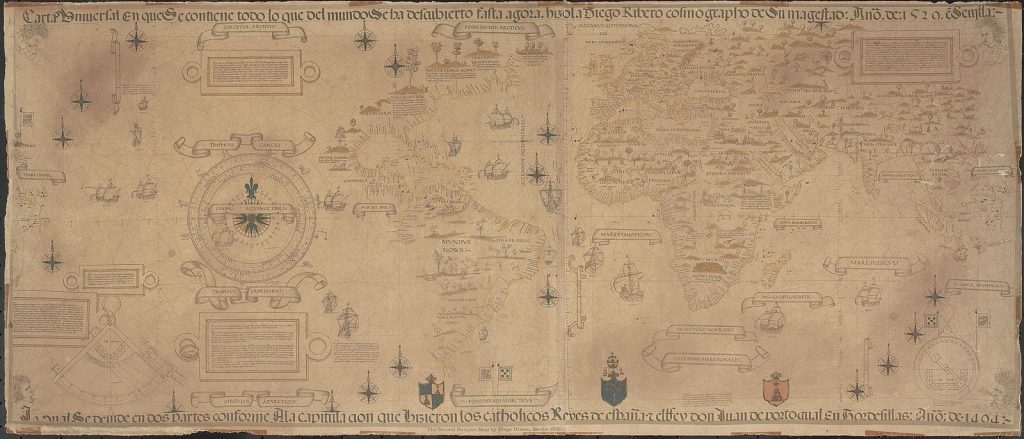
Planisphere traced by the Portuguese cosmographer Diego Ribeiro (1529). Wikimedia.
The readaptation of classical models of the earth to new geographic knowledge posed not only an intellectual challenge, but also an immense practical challenge for navigators and colonisers, as well as for the political powers that sent them to explore new lands, to seek a passage between the Atlantic and the Pacific south of the American continent, or to ‘discover’ a southern continent, which, according to these models, had to necessarily be somewhere around the south of the globe. These were not just texts or representations in two dimensions: the Portuguese and Castilian ships brought to Western Europe news that questioned what the classics had always affirmed: Africa was circumnavigable, the torrid area was inhabited and there were numerous islands and an immense continent of dimensions not yet defined towards the west. In a few decades, knowledge of the world, its nature and its inhabitants gained a dimension that, for the first time, was projected onto a truly global scale, passing before the eyes of sailors. Testimonies and information on all these developments, as well as plants, animals, objects and people from these ‘four corners of the world’ reached Lisbon and Seville. This expression, as the historian Serge Gruzinski has pointed out, was transformed into a motif that was captured, textually and visually, over and over again for two long centuries.
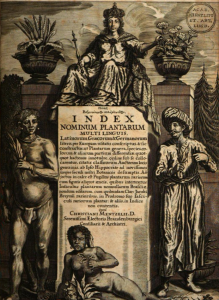
The four parts of the world, on the front cover of the Index Nominum Plantarum Universalis, by Christian Mentzel (1682). Gooble Books.
Broadly speaking, it could be said that this first globalisation was marked, from the perspective of the colonising empires, by three transcendental and interrelated processes: a commitment to Christianising the world as an indispensable instrument for the European colonial powers, precisely when the continent was itself engaged in a bloody confrontation between Catholics and Protestants; the exploitation of the economy, which revolved around the exploitation of colonial empires, the monetisation of exchanges and the development of an increasingly dense, multipolar and interrelated global trade network; and the growing awareness among European courts of the enormous importance of scientific knowledge and practices for the government of the states and colonies.
However, from the point of view of non-European cultures, this first globalisation was a challenge to survival, in the wide range of possible responses that moved between the opposite poles of resistance and assimilation. The enormous number of exchanges of knowledge, techniques and instruments has not yet been satisfactorily recomposed and recalibrated by the historiography of science, too long subjected to stories (or big pictures) built from the conviction of European supremacy. At present, there is no doubt that knowledge about nature, its productions and transformations was developed from multiple encounters between Europeans and non-Europeans. Thus, from the beginning, a body of mixed, hybrid and compound knowledge emerged, which missionaries and colonisers appropriated, thanks to militant Westernism which was embodied in two inseparable mechanisms, as Walter Mignolo has pointed out: modernity and coloniality. Such was the binomial mechanism with which Europeans sought to impose themselves on the rest of the globalised world.
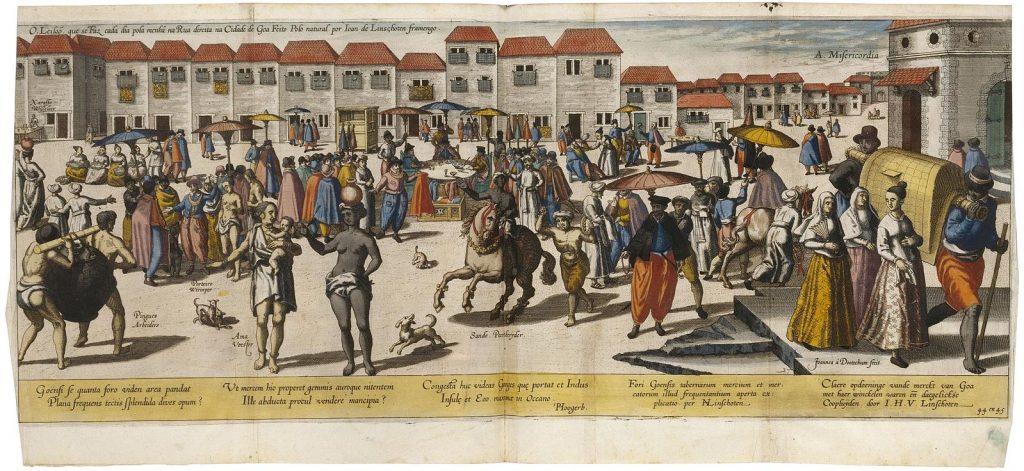
Goa market painted by Jan Huyghen van Linschoten circa 1596. Wikimedia.
The challenges posed by the need to organise and maintain empires – political, religious and military – of enormous proportions constitute the fundamental explanatory key to understanding the extraordinary development of scientific and technical activity in the sixteenth and seventeenth centuries. Exploring, exploiting, controlling and organising a colonial empire, trying to maintain military hegemony and religious unity required the mobilisation of enormous human and material resources. The scientific and technical component of many of these requirements explains the presence of engineers, architects, cosmographers, navigators, cartographers, doctors, surgeons, apothecaries, distillers and herbalists from all over the plethora of territories governed or controlled by European imperial policies.
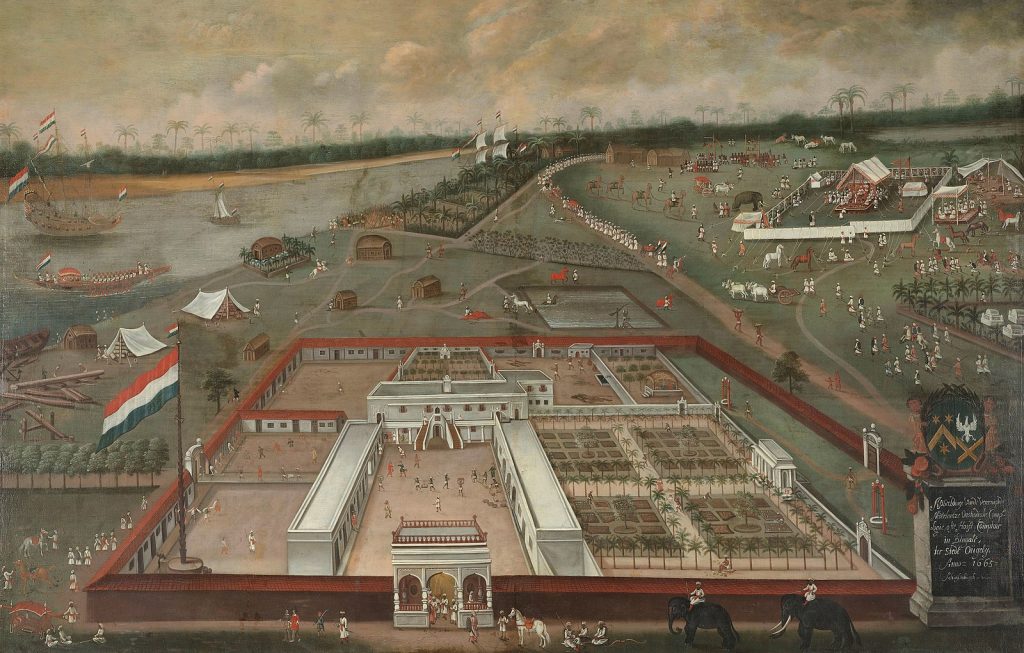
VOC (Dutch East India Company) factory at Hougly, Bengal, painted by Hendrik van Schuylenburgh around 1665. Wikimedia.
In addition to precious metals and economic monetisation, the natural wealth of the so-called ‘East and West Indies’ colonised by Europeans also brought other elements with enormous implications. The diets of Europeans, Asians, Americans and Africans, as well as the medicines and drugs with which they alleviated their diseases began to change with the flow of trade. These exchanges were not only reflected in the intensification of trade flows, but also in the introduction of new plants and animals, as well as in the intercontinental transfer (sometimes spontaneous, but much more often forced) of significant population groups, all transported in ships that were involved in increasingly intense transoceanic trade. Hybridisation, therefore, was reflected in nature itself, in the alterations of ecosystems, in the epidemic scourges and immunological resistance of humans and animals, as well as in the physiognomy of the inhabitants of the four corners of the world, due to the trade of enslaved people, migrations and the proliferation of mestizo processes.
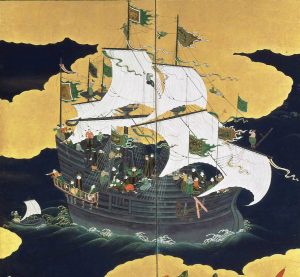
Kano Naizen, Namban art screen painting (“of the southern barbarians”) depicting a Portuguese ship arriving on the shores of Japan. Wikimedia.
New institutions and corporations were born to regulate, control and take advantage of this trade, serving as space for the production and circulation of new knowledge, techniques and instruments. First, the Casa da India in Lisbon, then the Casa de la Contratación in Seville; the various trading companies of the Castilians, Portuguese, Italians, Flemish and Germans founded in these ports; and the trading companies of the East Indies in the Netherlands and in England. The interests of their investors, bankers and traffickers stimulated the circulation of goods, but also of knowledge, both theoretical and practical, about the world, nature and ways of exploiting this. Everything was turned into a ‘matter of exchange’, as the historian Harold Cook has pointed out. These exchanges will be seen in future entries of Knowledge in action.
José Pardo Tomás
IMF-CSIC
How to cite this paper:
Pardo Tomás, José. Knowledge of a globalised world. Sabers en acció, 2020-12-09. https://sabersenaccio.iec.cat/en/knowledge-of-a-globalised-world/.
Find out more
You can find further information with the bibliography and available resources.
Recommended reading
Cook, Harold J. Matters of Exchange. Commerce, Medicine, and Science in the Dutch Golden Age. New Haven: Yale University Press; 2007.
Gruzinski, Serge. Las cuatro partes del mundo: historia de una mundialización. México: Fondo de Cultura Económica; 2010.
Mignolo, Walter D. (2003): Historias locales / diseños globales. Colonialidad, conocimientos subalternos y pensamiento fronterizo. Madrid: Akal, 2003.
Raj, Kapil. Relocating Modern Science. Circulation and the Construction of Knowledge in South Asia and Europe, 1650-1900. Basingstoke & New York: Palgrave Macmillan; 2007.
Studies
Delbourgo, James; Dew, Nicholas (eds.) Science and Empire in the Atlantic World. London: Routledge; 2008.
Flynn, Dennis O.; Giráldez, Arturo. China and the Birth of Globalization in the 16th Century. Aldershot: Ashgate.
Giraldez, Arturo. The Age of Trade. The Manila Galleons and the Dawn of the Global Economy. Lanham, MD: Rowman & Littlefield Publishers; 2015.
Nieto Oliarte, Mauricio. Las máquinas del imperio y el reino de Dios. Reflexiones sobre ciencia, tecnología y religión en el mundo atlántico del siglo XVI. Bogotá, Universidad de Los Andes; 2013.
Polónia, Amélia; Fabiano, Bracht; Conceição, Gisele C., eds. Connecting Worlds: Production and Circulation of Knowledge in the First Global Age. Cambridge: Cambridge Scholars Publishing; 2018.
Romano, Antonella. Fabriquer l’histoire des sciences modernes. Réflexions sur une discipline à l ‘ère de la mondialisation, Annales. Histoire, Social Sciences, 70 (2); 2015: 381-408.
Safier, Neil. “Global Knowledge on the Move: Itineraries, Amerindian Narratives, and Deep Histories of Science.” Isis, 2010; 101 (1): 133-145.
Sivasundaram, Sujit. Sciences and the Global. On Methods, Questions, and Theory. Isis, 2010; 101 (1): 146-158.
Subrahmanyam, Sanjay. Three Ways to Be Alien. Travails & Encounters in the Early Modern World. Waltham, Mass.: Brandeis University Press; 2011.
Websites and other resources
A more complete chronology of European geographical expansion. Available here.
A digital edition of the codex of the University de Valencia containing the text of Ptolemy’s Cosmographie, made between 1460 and 1477. Available here.
Journal of Vasco de Gama’s first trip to India. Available here.
Texts by Christopher Columbus on three of his four journeys. Available here.
Two projects on empires and European colonial expansion. Available here.
A commented bibliography on Iberian science and colonial empires prepared by Brian Jones and Jorge Cañizares in 2017. Available here.
Networking the Republic of Letters, 1550-1750. Available here.



